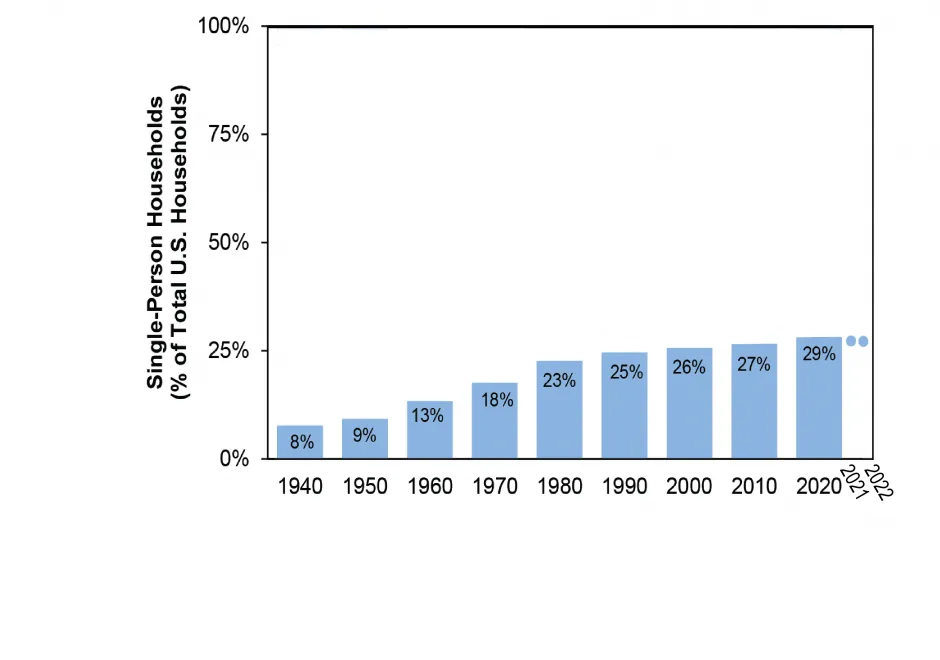Residential Buildings Factsheet
Patterns of Use
Although climate-specific, resource-efficient house design strategies exist, per capita material use and energy consumption in the residential sector continue to increase. From 2000–2020, the U.S. population increased by 17.8%, while the number of housing units increased by 21.5%.1,2,3 Between 2000 and 2020, urban land area in the U.S. increased by 14%. Urban land area is 3% of total land area in the U.S.1,4 The following trends illustrate use patterns in the residential building sector.
Size and Occupancy
- Increased average area of U.S. houses:5
- 1970s 1,647 ft2 ; 1990s 2,000 ft2 ; 2000s 2,131 ft2 ; 2010s 2,000 ft2
- 21% increase from 1970s
- Decreased average number of occupants in U.S. households:6
- 1970s 2.96; 1990s 2.64; 2000s 2.58; 2010s 2.55
- 14% decrease from the 1970s
- Increased average area per person in U.S. houses:5,6
- 1970s 556 ft2 ; 1990s 758 ft2 ; 2000s 826 ft2 ; 2010s 784 ft2
- 41% increase from the 1970s
- A majority of Americans live in single-family houses. In 2021, 70% of the 128.5 million U.S. households were single family.7
- In 1950, 9% of housing units were occupied by only one person.8 By 2022, this value had increased to 29%.9
Average Size of a New U.S. Single-Family House, 1970s and 2010s5,6

U.S. Single-Person Households8,9,10

Energy Use (See U.S. Energy System Factsheet)
- A University of Michigan study showed the average house in the U.S. consumed 147 kWh/ m2 annually in 2015.12
- Electricity consumption increased 14-fold from 1950 to 2022. In 2022, the residential sector used 1.42 trillion kWh of electricity, 35% of U.S. total electricity use.13
- In 2022, the U.S. residential sector consumed 21.8 quadrillion Btu of primary energy, 22% of U.S. primary energy consumption.14
- Miscellaneous plug loads per household doubled from 1976 to 2006.15 These are appliances and devices outside of a building’s core functions (HVAC, lighting, etc.) such as computers, fitness equipment, TVs, and security systems.16 In 2022, miscellaneous loads consumed more electricity than any other residential end use (lighting, HVAC, water heating, and refrigeration), accounting for 36% of primary energy and 50% of electricity consumption.11
- Wasteful energy uses include heating and cooling of unoccupied buildings and rooms, inefficient appliances, thermostat oversetting, and standby power loss.17 Heating and cooling account for 45% of the total energy use in the residential sector.11
- Home energy management systems display energy use via in-home monitor or mobile application and enable remote control of devices. Home energy management systems can reduce a house’s energy use by an estimated 4-7%.18
U.S. Residential Energy Consumption by End Use, 202211

Material Use (See U.S. Material Use Factsheet)
- The average U.S. single-family house built in 2000 required 19 U.S. short tons (tons) of concrete, 13,837 board-feet of lumber, and 3,061 ft2 of insulation.19
- From 1975 to 2000, the use of clay for housing and construction more than quadrupled, due to use in tiles and bathroom fixtures.20
- In 2012, around 24% of all wood products consumed in the U.S. were used for residential construction.21
- Approximately 10 million tons of waste were generated in the construction of new residential buildings in 2003—4.4 lbs per ft2. 22
- U.S. average recycling rate of waste from construction and demolition (C&D) is 20-30%.23 Seattle recycled 68.1% of its C&D waste in 2021.24
Codes and Standards
- DOE Pacific Northwest National Laboratory estimated cumulative savings from the International Energy Conservation Code (IECC) for 42 states. From 2010–2030, the IECC would save 3.44 quads of primary energy, 16% of residential primary energy consumption in 2022.14,25 Cumulative energy savings would generate $40.6 billion (2020 dollars) in cost savings and avoid 224.7 million metric tons (Mt) of CO₂.25
- Houses built to Energy Star program requirements are 20% more energy efficient than houses built to 2009 IECC or better.26
- Florida’s 2007 energy code saved 13% relative to pre-2007 energy consumption through reduction in heating, cooling, and hot water demand. Efficiency gains were offset by increasing house sizes and plug loads.27
- For most building types, conventional energy efficiency technologies can achieve a 20% reduction in energy use relative to the American Society of Heating, Refrigerating, and Air-Conditioning Engineers (ASHRAE) 90.1-2004 standard.28
Residential Building Energy Code Status by State29,30


Life Cycle Impacts
- Between 1990 and 2021, residential GHG emissions decreased less than 1%, reaching 954 Mt CO2e.31
- In 1998, CSS conducted a life cycle energy consumption inventory of a 2,450 square foot, single-family house built in Ann Arbor, Michigan.32
- Only 10% of the house’s life cycle energy consumption was attributed to construction and maintenance; 90% occurred during operation.32
- Energy efficiency measures reduced life-cycle energy consumption by 63%. Careful selection of materials reduced embodied energy by 4%.32
- Life cycle GHG emissions were reduced from 1,013 to 374 metric tons (t) CO₂e over the 50-year life of the house.32
- Top contributors to primary energy consumption were polyamide for carpet, concrete, asphalt roofing shingles, and PVC for siding, window frames, and pipes. Improved HVAC system and cellulose insulation were the most effective strategies to reduce energy costs.32
- Substituting recycled plastic/wood fiber shingles for asphalt shingle roofing reduced embodied energy by 98% over 50 years.32
- A 900-ft2 house in Davis, CA, demonstrated design and technologies to reduce energy consumption, such as LED lighting, efficient appliances, graywater heat recovery, and a radiant heating and cooling system. Annual energy consumption fell to 5,854 kWh, 44% less than a standard house of the same size and location. Electricity generation from rooftop PV made the house energy net-positive.33
- Operating energy accounts for 80-90% of a building’s life cycle energy consumption and embodied energy accounts for 10-20%. As energy efficiency improves and operating energy decreases, embodied energy accounts for a larger fraction of life cycle energy. Design and materials selection are key ways to reduce embodied energy.34
- Energy retrofits, reduced in-home fuel use, and encouraging denser settlement could decrease residential greenhouse gas (GHG) emissions.12
Solutions and Sustainable Alternatives
Reduce Operational Energy Demand
Energy and water consumption during the life of a conventional building contribute more to its environmental impact than its building materials. The following suggestions can significantly reduce operational energy demand:
- Downsizing: build smaller to reduce embodied and operating energy.35
- Operating energy can be reduced through passive space heating and cooling.32
- By adding ceiling fans, air conditioning can be comfortably set about 4oF higher.36
- Install low-flow water fixtures to save both water and energy.37
- Adequate insulation can reduce heating and cooling costs. R-value needs differ based on location, building design, and heating methods.38
- Water heating accounts for 13% of residential energy consumption.11 Save energy with a graywater heat recovery system.39
- Maximize natural lighting with south-facing windows. Properly shade windows to minimize summer heat gain.40
- Purchase energy efficient appliances and lighting. Appliances and lighting typically account for 24% of household energy costs.41
- Replace incandescent lamps and halogen lamps with LEDs to reduce energy costs and GHG emissions.42
- Pursue net-zero carbon/energy certifications including LEED, Living Building Challenge, GreenGlobes, BREEAM, Passive House.43
- Federal rebates, tax credits, and financing strategies are available to homeowners and renters when purchasing new efficient appliances and electrification technologies. These technologies can lower household energy use and incentives make cleaner technology more affordable.44,45
Select Durable and Renewable Materials
As operational energy is reduced, the embodied energy of building materials becomes more significant to long-term energy conservation and GHG emission reduction.46 Durable building materials last longer and require fewer replacements. Renewable materials generally have lower environmental burdens and many sequester carbon.
Center for Sustainable Systems, University of Michigan. 2023. “Residential Buildings Factsheet.” Pub. No. CSS01-08.
References
- U.S. Census Bureau (2012) United States Summary: 2010 Population and Housing United Counties. 2010 Census of Population and Housing.
- U.S. Census Bureau (2023) National, State, and County Housing Unit Totals: 2020-2022, Annual Estimates.
- U.S. Census Bureau (2022) National Population Totals and Components of Change: 2020-2022, Annual Estimates.
- U.S Census Bureau (2023) County-level Urban and Rural information for the 2020 Census.
- U.S. Energy Information Administration (EIA) (2023) Residential Energy Consumption Survey, 2020.
- U.S. Census Bureau (2022) Historical Household Tables.
- U.S. Census Bureau (2022) American Housing Survey 2021.
- U.S. Census Bureau (2000) Historical Census of Housing Tables: Living Alone.
- U.S. Census Bureau (2022) America’s Families and Living Arrangements: 2022.
- U.S. Census Bureau (2010) America’s Families and Living Arrangements: 2010.
- EIA (2023) Annual Energy Outlook 2023.
- Goldstein, B., et al. (2020) The Carbon Footprint of Household Energy Use in the United States. Proceedings of the National Academy of Sciences.
- U.S. EIA (2023) “Electricity Explained: Use of Electricity.”
- U.S. EIA (2023) Monthly Energy Review May 2023.
- Roth, K., et al. (2008) “Small Devices, Big Loads.” ASHRAE Journal, 50(6): 64-65.
- U.S. Department of Energy (DOE) Energy Efficiency and Renewable Energy (EERE) (2016) “Miscellaneous Electric Loads: What Are They and Why Should You Care?”
- Meyers, R., et al. (2009) “Scoping the potential of monitoring and control technologies to reduce energy use in homes.” Energy and Buildings, 42(2010): 563-569.
- Thayer, D., et al. (2015) Characterization and Potential of Home Energy Management (HEM) Technology. Pacific Gas and Electric Company.
- U.S. Environmental Protection Agency (EPA) (2013) Analysis of the Life Cycle Impacts and Potential for Avoided Impacts Associated with Single-Family Homes
- World Resources Institute (2008) Material Flows in the United States: A Physical Accounting of the U.S. Industrial Economy.
- APA-The Engineered Wood Association (2015) Wood Products and Other Building Materials Used in New Residential Construction in the United States.
- U.S. EPA (2009) Estimating 2003 Building-Related Construction and Demolition Materials Amounts.
- U.S. EPA (1998) Characterization of Building-Related Construction and Demolition Debris in the US.
- Seattle Public Utilities (2022) 2021 Annual Waste Prevention & Recycling Report.
- U.S. DOE, Pacific Northwest National Laboratory (2021) Impacts of Model Building Energy Codes –Interim Update.
- Energy Star (2020) “Utilities and Other Program Sponsors.”
- Withers, C., and R. Vieira (2015) Why Doesn’t 25 Years of an Evolving Energy Code Make More of a Difference? Behavior, Energy, and Climate Change Conference.
- Kneifel, J. (2011) “Beyond the code: Energy, carbon, and cost savings using conventional Technologies.” Energy and Buildings, 43(2011): 951-959.
- International Code Council (2020) Overview of the International Energy Conservation Code.
- Building Codes Assistance Program (2018) Residential Code Status.
- U.S. EPA (2023) Inventory of US Greenhouse Gas Sources and Sinks 1990-2021.
- Blanchard, S. and P. Reppe (1998) Life Cycle Analysis of a Residential Home in Michigan. CSS98-05.
- Payman, A., and F. Loge (2016) “Energy efficiency measures in affordable zero net energy housing: a case study of the UC Davis 2015 solar decathlon home.” Renewable Energy 101(2017): 1242-1255.
- Ramesh, T., et al. (2010) “Life cycle energy analysis of buildings: An overview.” Energy and Buildings, 42(2010): 1592-1600.
- Wilson, A. and J. Boehland (2005) Small is Beautiful, U.S. House Size, Resource Use, and the Environment. Journal of Industrial Ecology, 9(1-2): 277-287.
- U.S. DOE, EERE (2021) “Fans for Cooling.”
- U.S. DOE (2021) “Reduce Hot Water Use for Energy Savings.”
- Federal Trade Commission (2021) “What To Know When You’re Buying Home Insulation.”
- U.S. DOE (2021) “Drain-Water Heat Recovery.”
- U.S. DOE (2012) “Daylighting.”
- Energy Star (2013) “Where Does My Money Go?”
- Liu, L., et al. (2017) Replacement policy of residential lighting optimized for cost, energy, and greenhouse gas emissions. Environmental Research Letters. 12(11): 1-10.
- BuildingGreen (2020) A Review of the Current Net-Zero Energy and Net-Zero Carbon Certification Programs.
- American Council for an Energy-Efficient Economy (ACEEE) (2022) “Residential Electrification Isn’t Always Easy, but Implementation Barriers Can Be Overcome.”
- U.S. Department of Energy (2023) Energy Saving Hub, “Save Energy. Save Money. And Save the Planet Too.”
- Carbon Leadership Forum (2020) The Carbon Challenge

